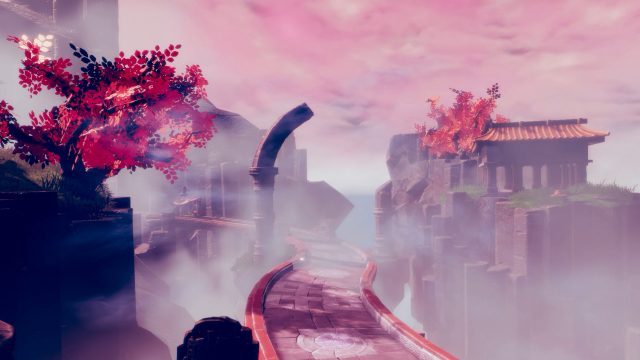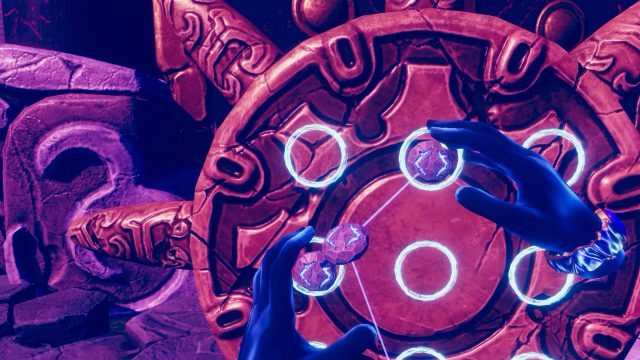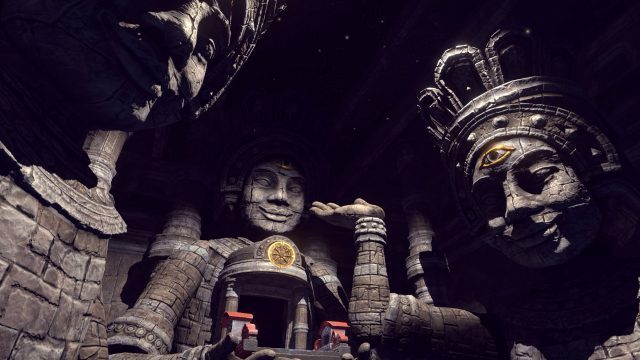From the makers of FORM (2017), a well regarded indie VR puzzle game, comes Twilight Path. With an entirely new setting, Twilight Path attempts something more ambitious than its predecessor, but winds up feeling like a rushed followup.
Twilight Path Review Details:
Developer: Charm Games
Available On: SteamVR (Vive, Rift), Oculus Store (Rift)
Reviewed On: SteamVR (Vive Pro)
Release Date: October 2nd, 2018
Gameplay
Opening with a short prologue about a spirit world that’s recently come under siege by a cursed dragon demon, Twilight Path begins ever so briefly in the human world before transporting you to the spirit world with little explanation, beginning a linear string of puzzles which can be fun but often feel arbitrary as you teleport from one puzzle node to the next.
Whereas Charm Games’ previous title, FORM, had a more abstract presentation which relied and usually succeeded with dazzling visuals, Twilight Path sets up a more structured world and introduces the player to a few characters in an effort to infuse the game’s puzzle gameplay with interesting context.

Unfortunately it fails on that front as the characters are ill developed and almost entirely without player interaction, serving more as a convenient in-game location for some voice acting work to emanate. By the end, the game tries to bring a little action into the mix and suss some emotion out of the player after a climactic scene, but fails to achieve a sense of danger or urgency, while lacking the requisite character development to make the player care about the outcome.
Failing in its overambitious attempt at world building, Twilight Path is left then with just its puzzles. While you’ll find a few new ideas, there’s plenty borrowed from FORM. While that’s not necessarily a bad thing, Twilight Path didn’t feel like it brought many innovative or memorable puzzle ideas to the table, and rarely offered me any “eureka” moments that are often accompany puzzle games that make you think outside the box.
Despite being usually fun to interact with thanks to (usually) good affordance design, FX, and SFX, puzzles largely felt like one-off contraptions. Twilight Path doesn’t really teach the player underlying concepts to later be tested in a challenging setting—the essence of most any game.

Even priced at a low $15, with a little over an hour of play time Twilight Path feels like it tries to do too much with its world in the time allotted, while not focusing enough on the player’s gameplay journey.
Charm Games says that Twilight Path serves as an introduction to its world and they plan to add more chapters to this tale in the future.
Immersion

In Twilight Path you’re described as a human who has come to the spirit realm, apparently a fairly uncommon happenstance. You’ve acquired several magical abilities (for some reason), allowing you to interact with objects at a distance, transform broken things into not broken things, and teleport from one predefined location to the next.
The purely linear nature of the game, coupled with node-based teleportation—which sometimes moves you hundreds of feet or more from where you just were in a matter of seconds—makes it hard to stay grounded in the game world as you’re often left wondering exactly where you are in relation to the rest of the environment.
While the game gives you abilities which on paper should feel empowering, they often feel more like a means of activating scripted sequences. For instance, early in the game there’s some giant boulders blocking a pathway. While you might want to use your force power to pick them up and move them off of the track, instead you can only use your force power to just click and hold on certain action nodes on the boulders which causes them to blow up after a few seconds (for some reason).
Other ‘puzzle’ elements involve using your force power to click and hold on an obvious node for a few seconds as a large broken object reforms into its unbroken shape. Again, it would have been more empowering if I got to physically manipulate the large pieces to put the object back together myself, instead of simple activating a scripted animation with a trigger hold.
Twilight Path is a decent looking game, but lacks some consistency in its environmental design. The first half of the game takes place in the large outdoor spirit realm setting which is mostly passable, but lacks character. In the latter half of the game you’ll find an immense spirit creature that’s surprisingly detailed and quite well animated for its size. From then on out you enter interior spaces which are significantly more detailed and occasionally awe inducing. Sadly, you’ll only spend a few minutes in some of the game’s most richly detailed areas.
Comfort
As the game is purely teleportation based, and doesn’t require you to move more than a step from your central position, it’s perfectly comfortable, save for a few moments where you’re riding on a slowly moving vehicle.
To use your force power at a distance, the game relies on cursors which are projected out into the world. Played with the Vive, the cursors moved with my hands in a somewhat unintuitive manner, making control a little less precise than it seems it should be. I think this may have been an effort to avoid simple laser pointing input (which is smart), but the result could have felt better.







